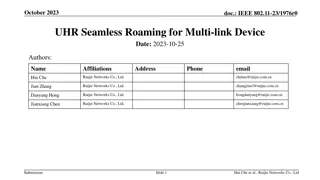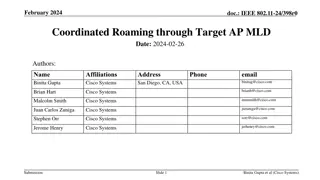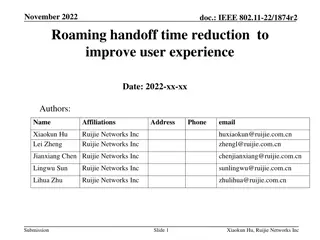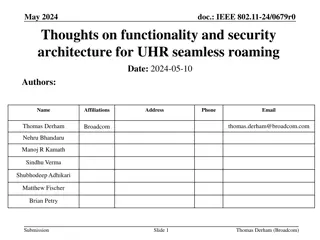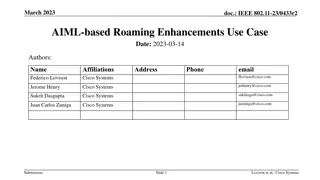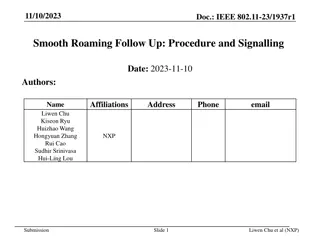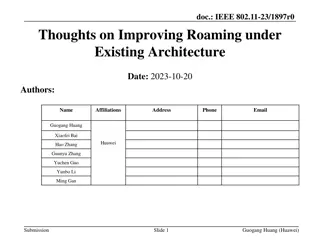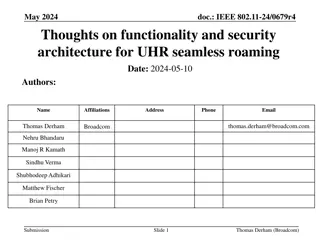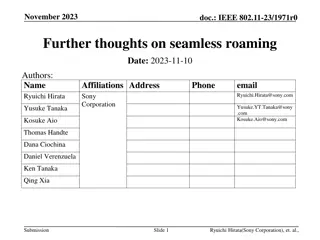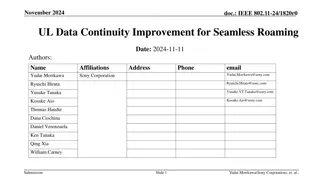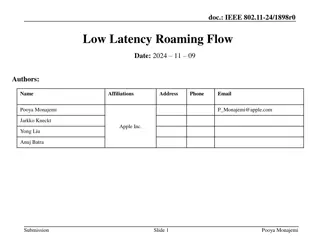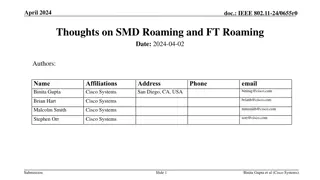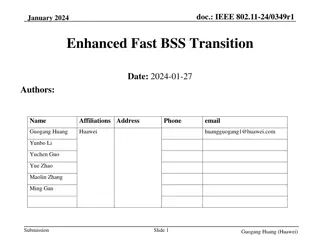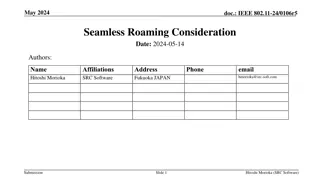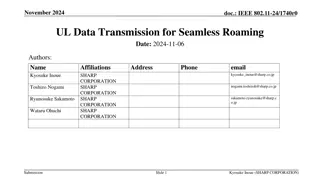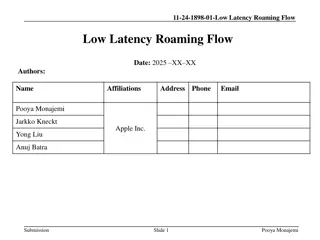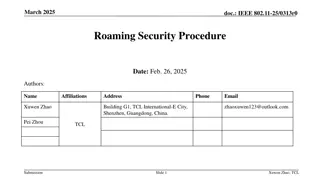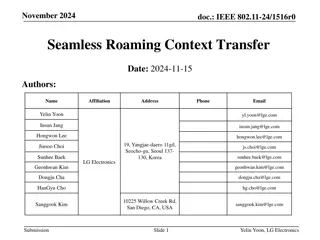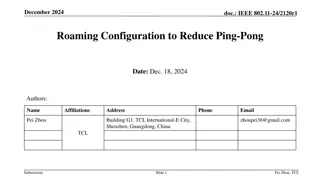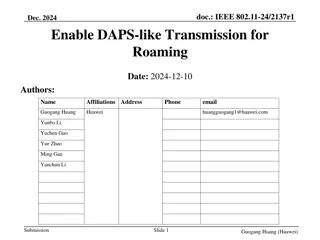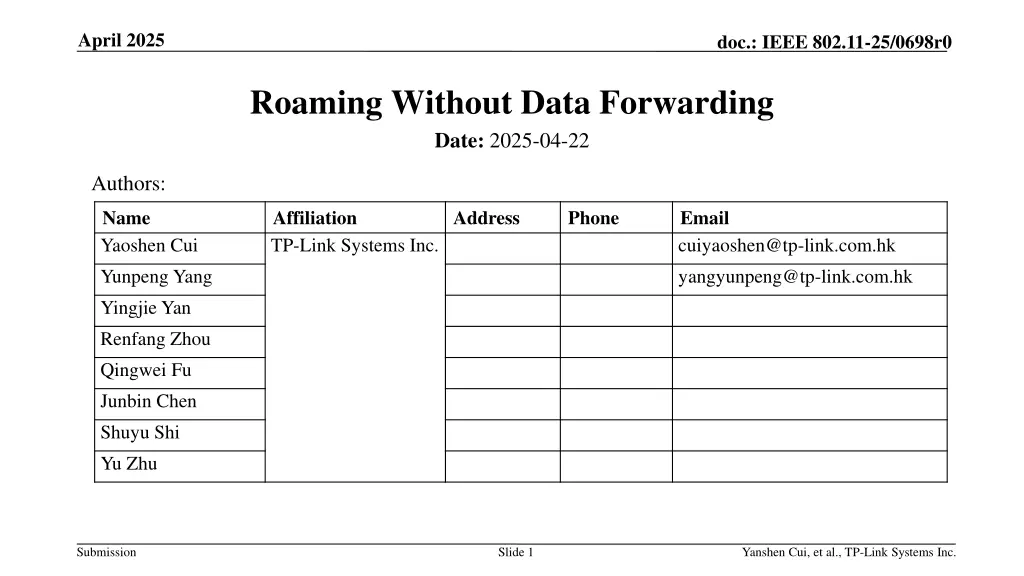
Improving Seamless Roaming Performance by Reducing Data Forwarding Burden
Explore the challenges of data forwarding in seamless roaming scenarios and propose a solution to enhance performance by reducing unnecessary data forwarding. The presentation delves into the impact of data forwarding on time-sensitive traffics and suggests a method where non-AP MLDs can request the current AP MLD to refrain from forwarding data during roaming. By analyzing potential impacts and data flows without data forwarding, the presentation aims to optimize the roaming experience.
Download Presentation

Please find below an Image/Link to download the presentation.
The content on the website is provided AS IS for your information and personal use only. It may not be sold, licensed, or shared on other websites without obtaining consent from the author. If you encounter any issues during the download, it is possible that the publisher has removed the file from their server.
You are allowed to download the files provided on this website for personal or commercial use, subject to the condition that they are used lawfully. All files are the property of their respective owners.
The content on the website is provided AS IS for your information and personal use only. It may not be sold, licensed, or shared on other websites without obtaining consent from the author.
E N D
Presentation Transcript
April 2025 doc.: IEEE 802.11-25/0698r0 Roaming Without Data Forwarding Date: 2025-04-22 Authors: Name Yaoshen Cui Yunpeng Yang Yingjie Yan Renfang Zhou Qingwei Fu Junbin Chen Shuyu Shi Yu Zhu Affiliation TP-Link Systems Inc. Address Phone Email cuiyaoshen@tp-link.com.hk yangyunpeng@tp-link.com.hk Submission Slide 1 Yanshen Cui, et al., TP-Link Systems Inc.
April 2025 doc.: IEEE 802.11-25/0698r0 Introduction During seamless roaming, DL data forwarding between AP MLDs within same SMD is proposed to improve reliability [1]. However, DL data forwarding may lead to bad experience for some time-sensitive traffics. Data forwarding may bring additional delay especially when wireless backhaul between AP MLDs. For some specific traffic that new data from DS is more valuable to transmit than the old data pending in current AP MLD s buffer, data forwarding is unnecessary. In this presentation, we show the scenarios where DL data forwarding may be a burden on roaming performance, and propose that non-AP MLD can request current AP MLD not to forward DL data to target AP MLD during roaming. Submission Slide 2 Yanshen Cui, et al., TP-Link Systems Inc.
April 2025 doc.: IEEE 802.11-25/0698r0 Recap: Data Forwarding in Seamless Roaming During seamless roaming, current AP MLD can forward buffered DL data of non-AP MLD to target AP MLD. on AP MLD urrent AP MLD arget AP MLD Data e c ange wit current AP MLD The forwarded data can be transmitted to non-AP MLD by target AP MLD only after roaming response. Pre aration e uest onte t ransfer Pre aration es onse If DS mapping update is complete, new data from DS arrives at target AP MLD. The new data is transmitted after the forwarded data. oa ing e uest onte t ransfer D a ing u date oa ing es onse DL data forwarding rans it forwarded data fro current AP MLD rans it new data fro D Submission Slide 3 Yanshen Cui, et al., TP-Link Systems Inc.
April 2025 doc.: IEEE 802.11-25/0698r0 Potential Impact of Data Forwarding AP MLD1 AP MLD2 Poor link Additional delay caused by data forwarding The link quality between AP MLDs is poor. The latency-sensitive data at AP MLD1 will timeout if forwarded to AP MLD2. Forwarding buffer buffer timeout Specific traffic that does not require data forwarding Vehicles on the road get nearby road conditions from roadside AP (also known as road side unit). When a vehicle moves, its serving AP switches from AP MLD1 to AP MLD2. The information from AP MLD2 is more important than that in AP MLD1, such that data forwarding is unnecessary. AP MLD1 AP MLD2 Road conditions around AP MLD1 Road conditions around AP MLD2 move Thus, data forwarding is not necessary in seamless roaming. We analyze the roaming procedure without data forwarding below. Submission Slide 4 Yanshen Cui, et al., TP-Link Systems Inc.
April 2025 doc.: IEEE 802.11-25/0698r0 Data Flows Analysis Without Data Forwarding When receiving roaming request, current AP MLD transmits dynamic context (including PN etc. but not Next SN) to target AP MLD. on AP MLD urrent AP MLD arget AP MLD D DL wit current AP MLD L wit current AP Pre aration e uest stab is A agree ents in ad ance tatic A onte t Pre aration es onse Current AP MLD may keep its transmission until the time indicated by roaming response. oa ing e uest L sus ension onte t ransfer P etc D u date indication During t e eriod of current AP MLD s transmission, if DS mapping update completes, new data from DS enters target AP MLD s buffer and ends for trans ission. oa ing es onse D a ing u date co ete L wit target AP MLD ecei e buffered data fro current AP MLD ew DL data buffer A A to a ign AP MLD DL wit target eset and rans it DL data When current AP MLD ends transmission (timeout or signaled), target AP MLD resets BA operation by a BAR/BA exchange to align SSN, and starts transmitting DL data from aligned SSN. Submission Slide 5 Yanshen Cui, et al., TP-Link Systems Inc.
April 2025 doc.: IEEE 802.11-25/0698r0 Dynamic Decision in Roaming Procedure Although roaming without data forwarding is beneficial for time-sensitive traffic, it cannot meet the requirements of high reliability. We propose that non-AP MLD can decide whether data forwarding is needed for specific TIDs according to the capabilities of candidate target AP MLDs and the requirements of current traffic. Thus, the discovery procedure before roaming should be improved to provide more information related to non-AP MLD s roaming decisions. The reporting AP provides the necessary and latest information of neighbor AP MLDs [4]. SMD level parameters: data forwarding support, etc. MLD level parameters: security capabilities in RSNE, power save capabilities, etc. Dynamic parameters: link state between reporting AP and reported AP, real-time load on reported AP Submission Slide 6 Yanshen Cui, et al., TP-Link Systems Inc.
April 2025 doc.: IEEE 802.11-25/0698r0 Examples for Dynamic Decision in Roaming Procedure According to the information acquired in discovery, we illustrate the cases where data forwarding is enabled/disabled. Case1: Data forwarding is not needed. Real-time live streaming traffic. Non-AP needs new data from DS as soon as possible, rat er t an t e b ocked data in current AP MLD s buffer Case2: Data forwarding is needed. Non-AP MLD suffers from poor link with current AP MLD. Non-AP MLD has high reliability requirements. High-speed link is available between current AP MLD and target AP MLD. on AP MLD urrent AP MLD arget AP MLD D on AP MLD urrent AP MLD arget AP MLD D DL wit current AP MLD AP MLD DL wit current Disco ery ia en anced M Disco ery ia en anced M oa ing e uest o data forwarding oa ing e uest nab e data forwarding onte t ransfer o e t onte t ransfer e t urrent DL sus ension D u date indication D u date indication Data forwarding oa ing es onse oa ing es onse D a ing u date co ete D a ing u date co ete DL wit target AP MLD f no data forwarding, ay retrie e buffered data fro current AP MLD AP MLD DL wit target eset and rans it DL data rans it DL data fro e t Submission Slide 7 Yanshen Cui, et al., TP-Link Systems Inc.
April 2025 doc.: IEEE 802.11-25/0698r0 Summary Data forwarding between AP MLDs may impede the performance of time-sensitive traffic during roaming. The link between AP MLDs may be poor, leading timeout of these forwarded data. For s ecific traffic, new data fro D is ore i ortant t an t e o d data ending in current AP MLD s buffer. Non-AP MLD can decide whether data forwarding is enabled according to its traffic requirements and the information acquired by discovery stage. The information acquired by discovery may include the SMD level parameters, MLD level parameters, and dynamic parameters. The data forwarding decision is made for per TID. Submission Slide 8 Yanshen Cui, et al., TP-Link Systems Inc.
April 2025 doc.: IEEE 802.11-25/0698r0 Reference [1] 11-24/0209 [2] 11-24/1898 [3] 11-24/1528 [4] 11-24/1879 Specification Framework for TGbn Low Latency Roaming Flow Pooya Monajemi et.al., Apple Details on Data Forwarding for Seamless Roaming Proposals for Expeditious Discovery of APs for Initial Association and Roaming Neel Krishnan et.al., Apple Ryuichi Hirata et. al., Sony Corporation Submission Slide 9 Yanshen Cui, et al., TP-Link Systems Inc.
April 2025 doc.: IEEE 802.11-25/0698r0 SP1 Do you agree that non-AP MLD can request not to forward buffered DL data of specific TID to target AP MLD? Submission Slide 10 Yanshen Cui, et al., TP-Link Systems Inc.

